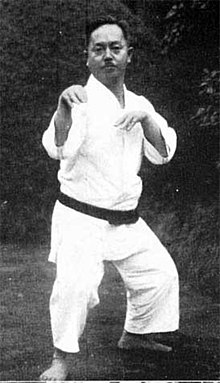Sūpārinpei

Sūpārinpei ( Japanese 壱 百零八 手 or ス ー パ ー リ ン ペ イ , Chinese yī bǎi línɡ bā ) is the highest and most difficult kata of the karate style Gōjū-ryū .
Origin and name
The origin of the kata is in the style of the 18 arhats . The Chinese meaning can be translated with the number 108 ( yī bǎi línɡ bā ). According to the Buddhist understanding, every person has 108 sources of unhappiness that he has to overcome in the course of his life. The number 108 refers on the one hand to the Buddhist origin of the kata and on the other hand to the number of techniques it contains.
Sūpārinpei is also called Petchūrin (Japanese 百 歩 連 or ペ ッ チ ュ ー リ ン , Chinese bǎi bù lián , German: unite the 100 steps ). The number 100 stands for a very large, almost innumerable amount, and the steps mean techniques. “Bai bu lian” therefore means: “A kata that combines many techniques”.
content
Sūpārinpei contains many open-hand techniques with an emphasis on two-handed techniques. The simultaneous use of both hands for counter techniques, double strokes and throws shows the high level of this kata and allows almost endless combinations.
Shōtōkan
Sūpārinpei is also practiced in a modified form in some currents of the Shōtōkan , for example the variant propagated by Tetsuhiko Asai , under the name Hyakuhachiho (Japanese 百八 歩 ) or Hyakuhappo . It is not one of the "standard kata" of Shōtōkan.
See also
- japanese karate expressions
- Zen
literature
- Horst Espeloer, Ulrich Heckhuis, Horst Nehm: Goju-Ryu Karate-Do. Basics, competition training, self-defense, kata . 2nd Edition. Selbstverlag , Dortmund 2008, ISBN 3-00-001342-3 ( table of contents ).
- Friedrich Gsodam: Goju-Ryu Karatedo. History, path and goal . Self-published, Vienna 1988, ISBN 3-900856-01-X ( description ).
- Gerd Hahnemann: Goju-Ryu Karate-Do. Kata and Bunkai . 1st edition. Self-published, Thalheim 2003 ( description - without ISBN).
Videos
- Andreas Ginger: Goju-Ryu Kata. Video production Geupel ( DVD , no age limit , approx. 100 min)
- Mario Holderbach: Goju-Ryu-Kata. Best Fitness Solutions (DVD, no age limit)
